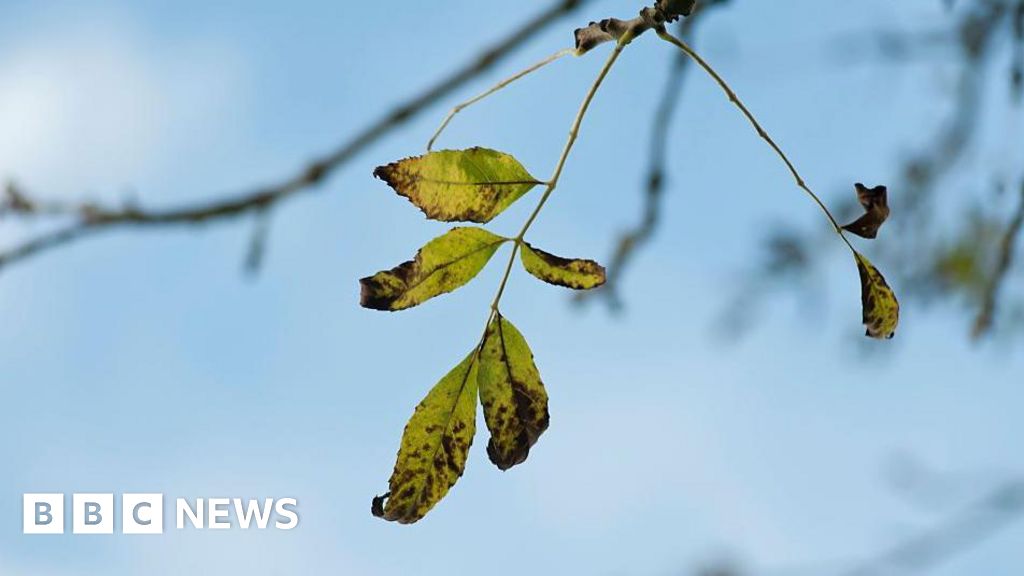Ash trees are fighting back against a disease that has ravaged the British countryside, new scientific evidence shows. When ash dieback arrived in 2012, predictions suggested up to 85% of ash trees could be lost. But now scientists have discovered that ash woodlands are naturally evolving greater resistance to the infection. The discovery offers renewed hope that the much-loved trees will survive in the British landscape. "It is hope born out of the death of a lot of trees," said Prof Richard Buggs of the Royal Botanic Gardens Kew, and Queen Mary University of London. But he said other interventions would be needed to give ash trees a helping hand, such as protecting trees from grazing deer and breeding the most resilient trees for future planting schemes. "We have fresh motivation to look after our ash populations, to protect them from other problems like deer browsing, and to let nature take its course and evolve trees with more resistance," he told BBC News. The Ash dieback fungus originated in Asia and was introduced to Europe about 30 years ago. The study of ash trees at a woodland in Surrey revealed subtle shifts over time in different genes, which should help new saplings fight back against it. The trees are evolving greater resistance to the disease than their predecessors - an example of Charles Darwin's natural selection theory in action. Richard Nichols, professor of evolutionary genetics at Queen Mary University of London, said a "tragedy for the trees has been a revelation for scientists: allowing us to show that thousands of genes are contributing to the ash trees' fightback against the fungus". Ash dieback demonstrates how devastating introduced pathogens can be for our trees and the species which rely upon them, said Rebecca Gosling of the Woodland Trust. "The findings highlight how vital it is to support natural regeneration in woodlands, furthering our understanding of how to best manage our ash woodlands," she said. Scientists had feared the ash would go the way of the elm, which has been almost wiped out by Dutch elm disease. The loss of the native tree would have a devastating effect on biodiversity as well as changing the face of the landscape. Since its arrival in Britain in 2012, ash dieback has spread to every corner of the British Isles, causing widespread damage to woodlands. Ash fungus genetic code unravelled Alarm call as world's trees slide towards extinction Ash tree set for extinction in Europe Signs of the disease can be seen through withered and blighted leaves. In many cases the fungal disease will eventually kill the tree. The research is published in the journal,Science.
Britain's ash trees evolving resistance to dieback, study shows
TruthLens AI Suggested Headline:
"Research Indicates Ash Trees in Britain Developing Resistance to Dieback Disease"
TruthLens AI Summary
Recent scientific research indicates that ash trees in Britain are developing a natural resistance to ash dieback, a disease that has significantly impacted the countryside since its introduction in 2012. Initial projections estimated that up to 85% of ash trees could be lost due to this fungal infection. However, studies conducted in a woodland in Surrey reveal that these trees are undergoing genetic changes that enhance their ability to withstand the disease. Professor Richard Buggs from the Royal Botanic Gardens Kew and Queen Mary University of London emphasized that while this evolution offers hope for the survival of ash trees, additional measures are necessary to support their resilience. These measures include protecting the trees from grazing deer and selectively breeding the most resistant specimens for future planting initiatives. Buggs noted that this situation represents a paradox: the loss of many trees has led to a newfound motivation to protect and nurture the remaining ash populations in the British landscape.
The ash dieback fungus, which originated in Asia, was introduced to Europe approximately three decades ago and has since spread throughout the British Isles, causing extensive damage to woodlands. The findings of this research highlight the importance of supporting natural regeneration in woodlands to enhance the resilience of ash trees against invasive pathogens. Professor Richard Nichols, also from Queen Mary University, remarked that the tragedy faced by these trees has provided valuable insights into the genetic factors contributing to their fight against the fungus. Rebecca Gosling from the Woodland Trust stressed the critical need to understand how to manage ash woodlands effectively in light of these revelations. The potential extinction of ash trees could have dire consequences for biodiversity and the landscape, echoing the historical loss of the elm to Dutch elm disease. The study's results, published in the journal Science, underscore the ongoing battle between native species and introduced diseases, while offering a glimmer of hope for the future of Britain's beloved ash trees.
TruthLens AI Analysis
You need to be a member to generate the AI analysis for this article.
Log In to Generate AnalysisNot a member yet? Register for free.
